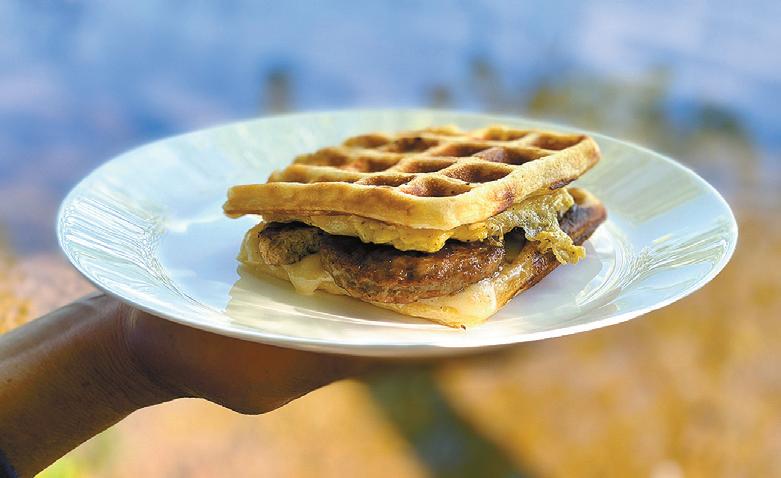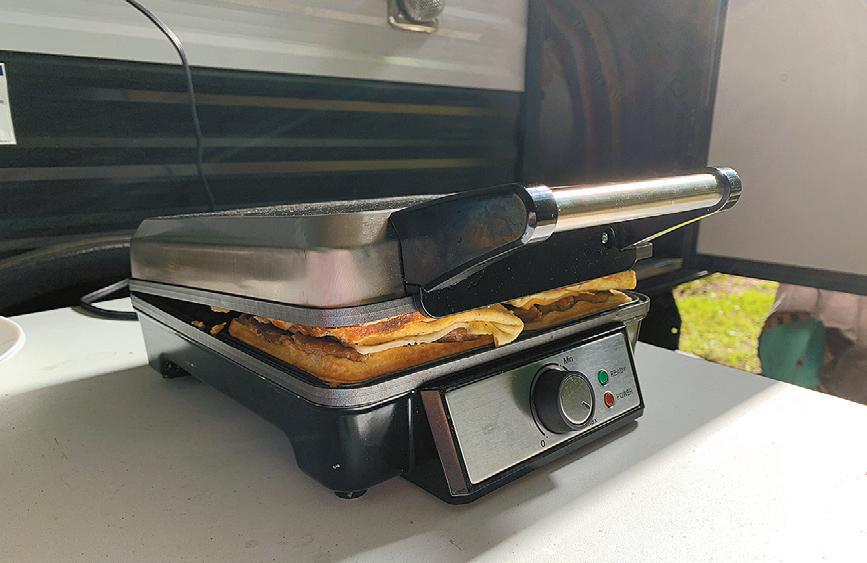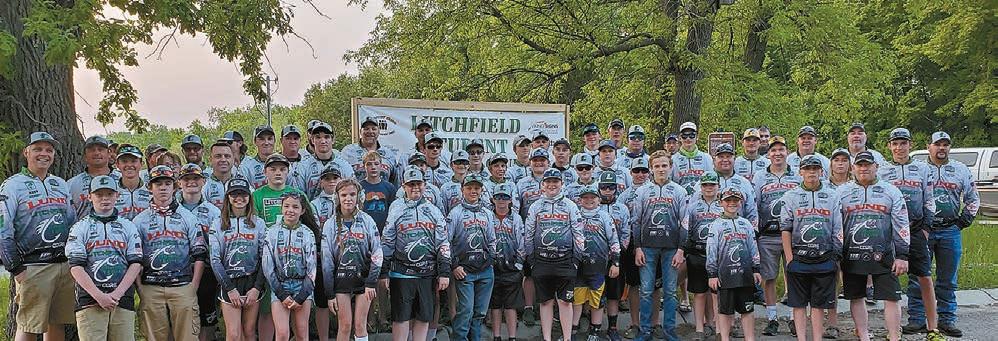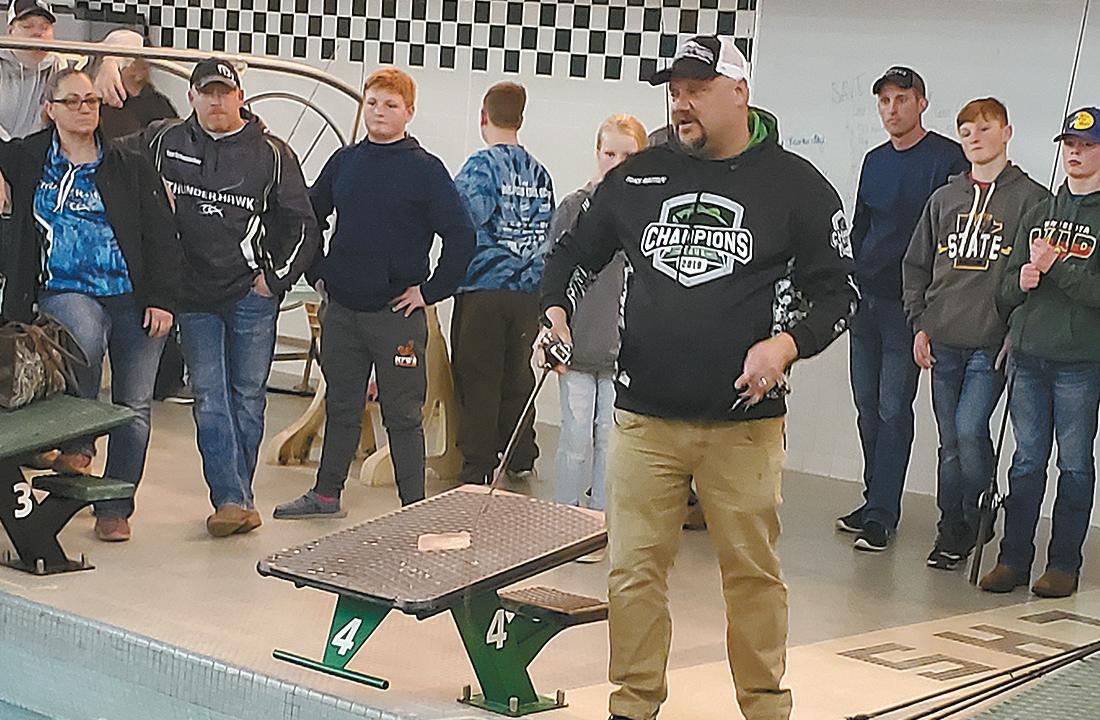
7 minute read
Padua
Camping Waffle Sandwiches COUNTRY ACRES AT THE LAKE ACCORDING TO: Jan Lasar
Bowlus / Morrison County
This is my favorite camping food and a modifi ed version of a waffl e recipe from the Better Homes and Gardens cookbook. It substitutes butter for oil, which gives the waffl e a delicious, buttery taste and extra crispiness.
Waffl es:
1 3/4 cups all-purpose fl our 1 tsp. baking powder 1/2 tsp. baking soda 1/4 tsp. salt 2 eggs, separated 2 cups buttermilk 1/2 cup butter, melted Stir together dry ingredients in a bowl. In another bowl, lightly mix egg yolks until they’re creamy, then stir in milk and butter. Combine beaten egg yolks with the fl our mixture. Beat egg whites until stiff peaks form and gently fold them into the fl our and egg yolk mixture. There should be a few fluff s of egg whites left; do not over-mix. Bake waffl es on a waffl e maker according to manufacturer’s instructions. Makes about 10 waffl es, depending on your waffl e maker.
Fillings:
Your favorite sliced cheese Your favorite cooked breakfast meat Egg pillows (recipe below)

Egg Pillows:
Use one egg per waffl e sandwich and make one at a time. Whisk egg like you’re making scrambled eggs; mix in a splash of water, maybe a 1/2 tsp. (The steam from the water helps fluff the egg). Add salt, pepper and other seasonings, if desired. Preheat a 12-inch cast iron skillet on medium heat and lubricate with cooking spray. Pour egg into skillet and move skillet around to cover the pan evenly with egg, do not stir. The idea is to make a very thin omelet that cooks quickly. Once the egg begins to set up, gently loosen the edges with a rubber spatula and fold the egg circle on itself until it’s about the same size as a waffl e. Repeat. If this sounds too complicated, you can make scrambled eggs, instead, but the pillows are fluffi er and stay on the waffl es better.
Assembly:
Top one waffl e with meat, one egg pillow and cheese. Put another waffl e on top, making a sandwich. Put the sandwich on the waffl e iron and bake it until the cheese is melted and everything is heated up. To make things easier at camp, the batter can be made ahead and stored cold in a mason jar. You can also use precooked breakfast meat and scramble your eggs for the egg pillows all at once, then measure them out evenly as you make the pillows. Pro tip: Make extra waffl es, they make a heck of a burger “bun”. This recipe is very versatile. Pretty much anything you like to eat sandwich style can be served this way.



PHOTO SUBMITTED
Dragons captain Michael Carl (right) teaches members of the Litchfi eld Student Anglers Club how to tie knots.

PHOTO SUBMITTED
The Litchfi eld Student Anglers Club gives kids a chance to learn how to fi sh and members can compete in fi shing tournaments. Members learn about water safety, how to read the lake and how to scout out the best locations for fi sh.
fi shing teams and competitive angling, he launched the club. The organization is in its third year and this June, one of the Litchfi eld teams that qualifi ed last season will head to a national angling competition in La Crosse, Wisconsin. The tournaments follow The Bass Federation rules and Minnesota hosts a qualifying tournament for the nationals. Annually, the tournament hosts 200 to 300 teams and last year qualifi ed 13 teams for nationals. More than anything, Anderson said, the anglers club is a way for families to create a new hobby and connections. He watches as fi shing teams that hit the water in groups of two with an adult captain go grab a burger after their time on the lake. “The camaraderie is pretty neat,” Anderson said. Success in competitive fi shing is a science and begins long before fi shing opener. Beginning in January, Anderson hosts six classroom nights for the club, every other Sunday for two hours. During those classes, students learn about invasive species and hear from lake biologists, conservation offi cers and pro fi shermen. They learn about boat safety and work through stations where they learn about tackle, knots and technique. The club heads to the high school swimming pool to practice different techniques on the water and see how different weights react. They learn the basics of casting and skipping in the middle of winter. They also study lake contour maps. Anderson encourages students to look for oddities in the lake, such as steep break lines or deep water surrounded by a shallow, fl at weed base. They mark up their lake maps on their laptops and talk about them with a PowerPoint presentation. Then, those maps get loaded onto an SD card and can plug directly into graphing software on a Humminbird system in a boat. Some of the adult volunteer boat captains have thousands of dollars wrapped up into the fancy technology, and other students make their way with maps, waypoints, a depth fi nder and GPS to the spots they discussed in class. All of them learn how to use the Humminbird system. The success of
Did youDid you know?
According to the Minnesota Department of Natural Resources: “A lake is not defi ned by size or depth as some may suggest. A lake may be defi ned as an enclosed basin fi lled or partly fi lled with water. A lake may have an inlet and/or an outlet stream, or it may be completely enclosed. Generally, a lake is an area of open, relatively deep water that is large enough to produce a wave-swept shor e.”
PHOTO SUBMITTED
Classic Bass Pro Tony Hatten, president of the Granite City Bassmasters Club, does a pool demonstration for the Litchfi eld Student Anglers Club.

any fi shing expedition depends on wind, sun and weather patterns, Anderson said. When he’s out on the lake in the spring he brings up a temperature graph in his boat and looks for warmer water; even one to two degrees warmer than the rest of the basin, he said, is where the fi sh will gather. In the summer he looks for a thermocline, where dissolved oxygen doesn’t mix with the lower surfaces of the water so, below a certain depth, fi sh can’t live and instead, suspend in the water just above that area. When it comes time for tournaments, Anderson said, teams often use their maps to pre-fi sh the lake and make sure they’ve found some waypoints where there’s good-quality tournament fi shing spots. Typically, the tournaments the teams enter are bassonly tournaments, though occasionally, they enter multi-species tournaments. Normally there is a big start to a tournament and students race off to their pre-determined fi shing spots, but tournaments this summer will have a staggered start with the onset of COVID-19. While some tournaments require weigh-ins of fi sh and hand out scales at the beginning of the competition, they’re forgoing that this year and opting instead to have kids photograph their fi sh
PHOTO SUBMITTED
Dan Anderson is the founder of the Litchfi eld Student Anglers Club. The club provides an opportunity for kids to learn to fi sh and, as they advance, compete in tournaments.

on a measuring line and upload the photo to an app to record the size of their catch. The app tells them when they can start and when they must stop, and it records all their fi sh, submitting the top catches of the day from each attendee. All the tournaments they attend, Anderson said, focus on catch and release. The most experienced fi shermen in the angling club participate in high school tournaments. There are also tournaments for kids 14 and under. In addition, Anderson’s league fi shing nights work just like a tournament with the kids competing. The league is supported by booster fees and grants from various organizations. The Litchfi eld team has support from 3M and gets sponsorships from companies like Lund for their offi cial team jerseys. The organization does have a registration fee that covers costs for the entire winter training as well as the summer league. For Anderson, the Litchfi eld Student Anglers Club has become a place to watch kids and families grow. “I’ve seen shy kids who can’t compete in the other sports become very competitive in this,” he said. “I’ve seen a numbe r of kids break out of their shells.”





